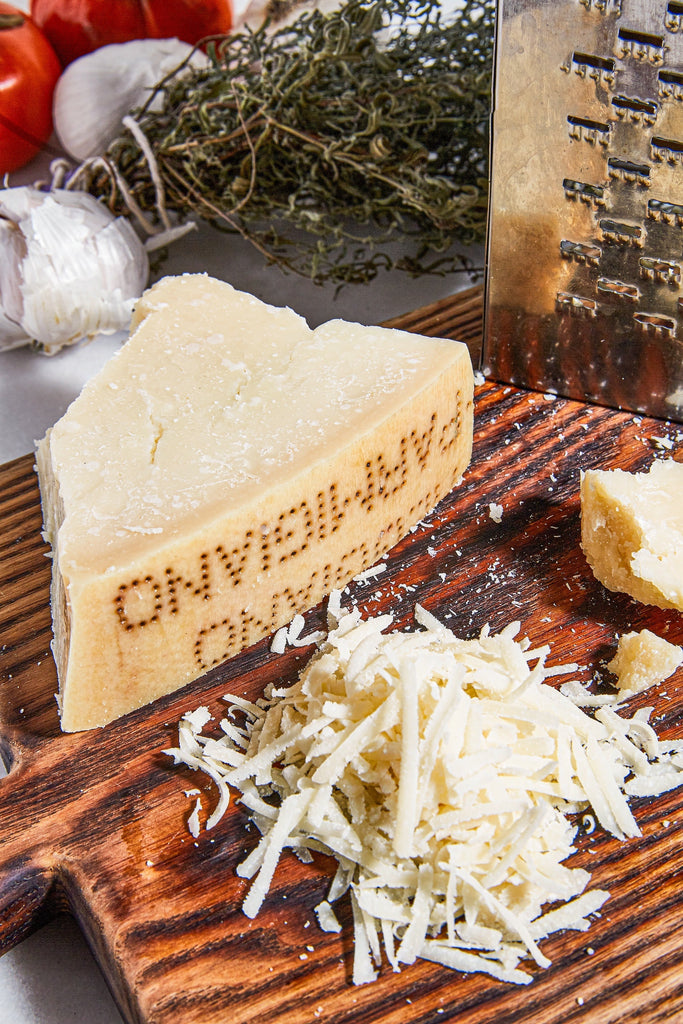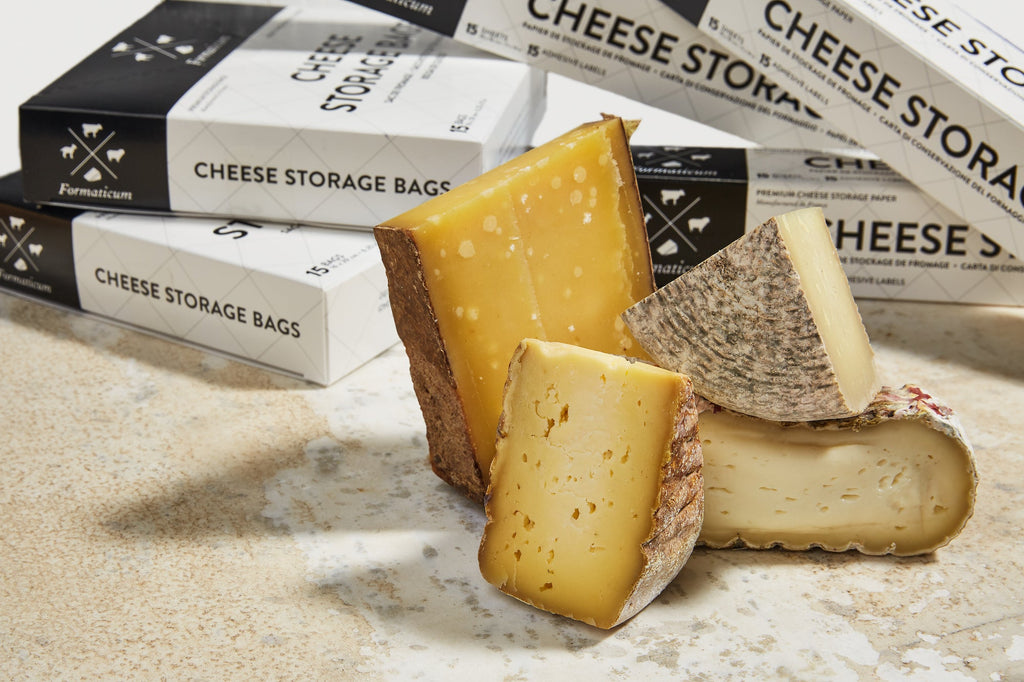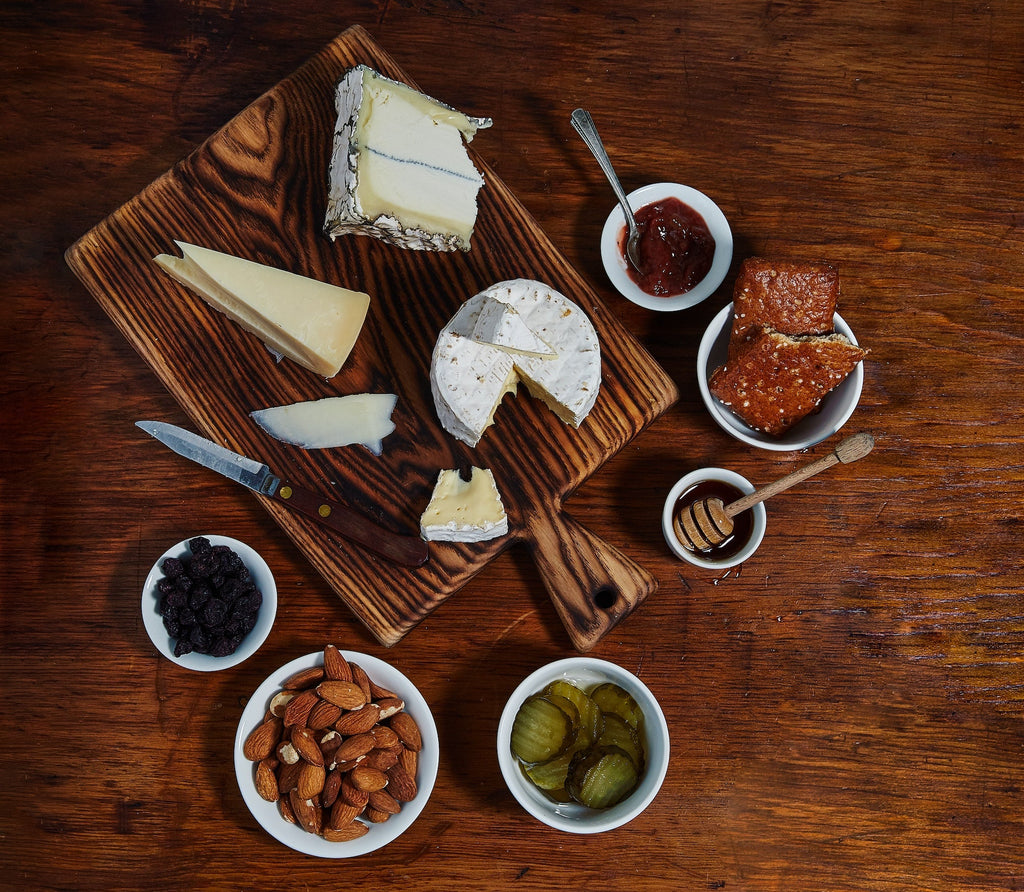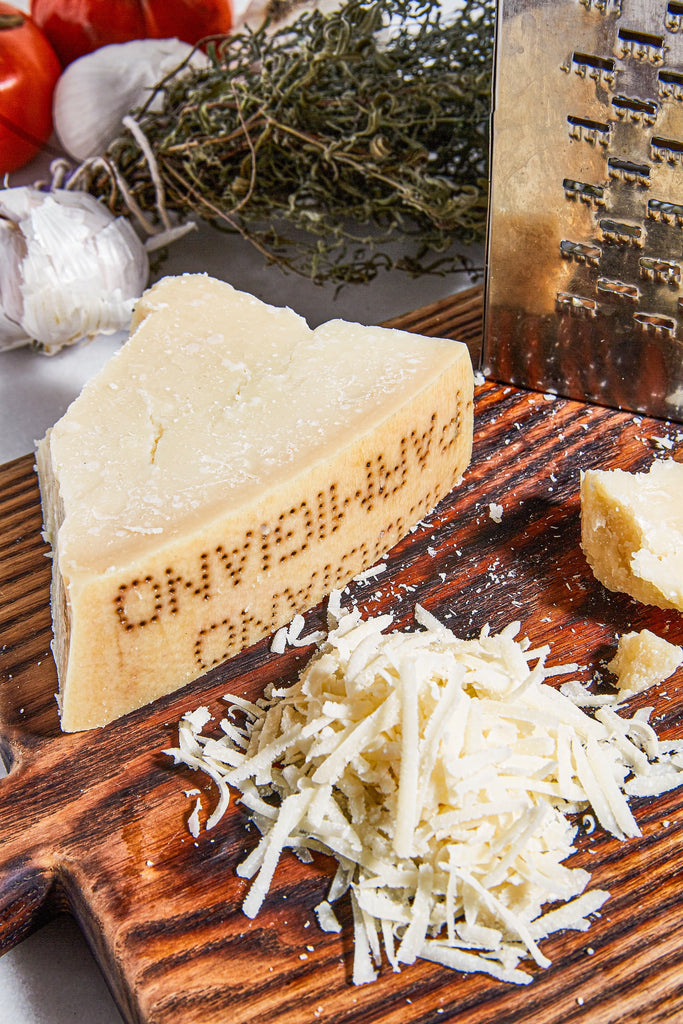The Versatility of Cheese

Cheese is one of the most widely consumed foods all over the globe, and it's also one of the most versatile fermented foods available. It has origins in the Fertile Crescent, and people across all cultures have incorporated various types of fermented dairy products into their diets for thousands of years. There are no rules when it comes to eating and enjoying cheese - and while some recipes and dishes can be considered classics, there is always a new way to expand your horizons and include cheese in everything you do in the kitchen. Here are some of our favorite, and perhaps unexpected, ways that the folks here at Formaticum incorporate cheese into our every day lives:
- A good cream cheese, farmer's cheese, or cottage cheese can be spread on a piece of toasted sourdough and topped with extra virgin olive oil and flaky salt, thick-cut heirloom tomatoes, and even a few strips of crispy bacon.
- Cheese with fish? The Italians may consider this blasphemy, but a briny Pecorino Romano or Pecorino Sicilian is the perfect garnish for a pasta or risotto with mussels or clams.
- A plate with a few chunks of Cheddar or Gruyère, apple slices, and some almonds or cashews is a balanced and filling mid-afternoon snack.
- Did you know that Vermont Cheddar and Vermont maple syrup are a perfect pairing? This information comes straight from our friends at Shelburne Farms, where both products are produced - they're obviously the experts!
- A friend of Formaticum from Quesos Navarro out of Mexico recommended pan-frying slices of Panela and drizzling them with honey for a sweet treat.
- A stretched-curd cheese like Quesillo or Queso Oaxaca can be substituted in any recipe that calls for mozzarella.
- Is your fridge full of forgotten odds and ends of various cheeses? Sounds like it's time to make some French-inspired Fromage Fort!
- Drain a few cups of Greek yogurt in cheesecloth overnight to make Middle Eastern labneh, which can be mixed with good olive oil and your favorite spice blend and eaten as an incredible dip with fresh pita or your favorite crackers.
- Parmigiano Reggiano, aka the King of Cheese, is more than just a grating cheese - the Italians love to eat chunks as a snack or table cheese, or drizzled with balsamic vinegar. You can also bake grated Parmigiano Reggiano until crunchy, creating satisfying cheesy chips called Frico, and don't throw away those rinds! Throw them into a soup, sauce, or stock for an extra level of savory umami.
- Blue cheese leftovers can be combined with sour cream and other spices for a quick homemade blue cheese dressing, or even a blue cheese sauce for your next steak dinner.
- If you serve a cheese plate at a dinner party or get-together and not all the cheese is eaten, don't put it back in the fridge - keep it under a glass cloche on the counter overnight and enjoy it for breakfast with some toast or melted into your eggs.
- Speaking of eggs, a soft scramble is easily elevated by whisking in or crumbling some fresh chèvre/goat cheese for a bright, tangy, creaminess.
No matter how you use cheese, the most important thing to do is to store it properly to keep the flavor at its peak, whenever you eat it. Our new Reusable Cheese Storage Bags and Sheets provide our strongest and most effective cheese protection yet, and are suitable for all styles of cheese.
Do you have a favorite way to use cheese that we did not mention? Send us an email at hello@formaticum.com and we will give it a try in the Formaticum test kitchen!
Women's History Month: March 2025

Women are and always have been inherently connected to cheese. Cheesemaking was traditionally a woman's task, as evidenced by written record as well as historic recipes - for example, some of the earliest cheddar-style recipes were very forgiving and included a long, slow acidification to allow for the cheesemaker to accomplish other tasks during the day. Many families owned a few cows and women were responsible for milking them and turning that bit of milk into cheese, the ultimate value-added product. The blueprint for many homes and creameries included a make room that was connected to the kitchen so that the cheesemaker could keep an eye on the vat while working on other things. The invention of Camembert is credited to Marie Harel, and the artisan cheese renaissance in the United States would not have been possible without the Goat Ladies of the 80s, a group of goat farmers who began making French-inspired chèvre and changed the landscape of the American cheese scene forever. Today, women all over the world and from diverse backgrounds work hard to both uphold this legacy and create their own - from cheesemakers to affineurs, educators to importers, farmers to buyers, women continue to be integral to the cheese industry, now more than ever.
Keep reading to learn more about some of our favorite women in cheese:
Anna Landmark, Landmark Creamery - Landmark Creamery was founded in 2013 in Paoli, Wisconsin. Anna knew that she had access to some of the best quality milk in the state and dreamed of using that milk to create excellent sheep’s milk cheeses. In addition to their sheep’s milk cheeses, Landmark Creamery also produces a line of stellar cow’s milk cheeses and a few styles of decadent small-batch butter. In order to guarantee the highest quality milk, they work with nearby farmers to build sustainable, family-run dairies that also help support the local economy in Southern Wisconsin.
Veronica Pedraza, Blakesville Creamery - Veronica is no stranger to the cheese scene, having worked for some of the most well-known creameries in the US before landing at Blakesville. As head cheesemaker, she has spent the last few years creating some of the most exquisite goat cheeses on the market, which can now be found on most of the best cheese counters in the country. Veronica and her team also make some incredible sheep's milk cheeses using milk sourced from Mariana Marques de Almeida, which you will learn more about below.
Mariana Marques de Almeida, Ms. J & Co. - Mariana is the queen of sheep's milk in Wisconsin. This woman-run sheep dairy is known for their high quality and high-yield milk that produces an exceptionally clean flavor in the cheese, so it's in high demand! The milk comes from a hybrid breed called Assaf, which is frequently used in Spanish and Portuguese cheesemaking. Mariana provides milk for cheesemaking to Landmark Creamery, Blakesville Creamery, and more.
Patricia Morford, River's Edge Chèvre - Patricia Morford uses the freshest milk from her own herd of goats to create award-winning French-inspired goat cheeses in Oregon. A former chef, Patricia is fascinated by flavor development and employs that curiosity to create unique and delicious cheese that are ash-ripened, bourbon-infused, and even leaf-wrapped and smoked. Many River's Edge cheeses are wrapped in Formaticum paper to keep them looking and tasting fresh in your refrigerator!
Kyra James, Own Your Funk - Kyra is a cheesemonger, educator, and consultant whose passion for cheese and community makes her one of the most well-loved members of the cheese industry. She is also an American Cheese Society Certified Cheese Professional, and a Cheesemonger Invitational finalist. Her brand, Own Your Funk, promotes food education and empowerment within marginalized communities. Kyra is also a board member of the Cheese Culture Coalition, an organization that aims to provide professional advancement and educational opportunities to BIPOC folks in the cheese industry and beyond.
Amye Gulezian, High Lawn Farm - Amye is the Specialty Foods Operations Manager at High Lawn Farm in Lee, Massachusetts, a family-owned dairy farm in the Berkshires that milks 100% Jersey cows and was founded by a woman named Marjorie Wilde. Amye studied heritage breed and dairy management in France, made raw milk cheese in Indiana, and was a cheesemonger in LA before settling at High Lawn Farm. Amye's main role is to help develop value added products like cheese, butter, and ice cream, with a focus on product quality and consistency as well as relationships with customers and vendors. High Lawn Farm makes some of the best butter we've ever tasted, and it's wrapped in Formaticum paper!
Sue Miller, Birchrun Hills Farm - Formaticum's blog author is a Pennsylvania resident, so we couldn't write a blog post about women in cheese without including the illustrious Sue Miller. Since 2006, Sue and her family have been making and aging farmstead cheese from the milk of their 80 cows, and are committed to sustainable farming and cheese production. They practice regenerative agriculture and maintain a high level of animal welfare, and their love of the craft can be tasted in their cheese.
Formaticum's motto has always been "Honor the cheesemakers. Save your cheese." In our opinion, the best way to honor the work of these amazing women is to properly care for their cheeses so that they taste their best for as long as possible. Store your cheese in Formaticum Cheese Storage Bags and Sheets to experience the flavors and textures of your cheese as the cheesemaker intended.
Beginner's Guide to Cheese Pairings

One of the most common questions to ask your cheesemonger is undoubtedly, "What should I pair with this cheese?" and while many "classic pairings" can provide a helpful guide to pairing basics, it's important to remember that there are no hard and fast rules - it's all about what tastes good to you! Cheese pairing is truly subjective, and we encourage you to experiment with different flavors and textures to help you develop your palate and personal preferences.
As a general rule, you want a pairing to either contrast or complement the flavor of the cheese. It's important to make sure the flavors are balanced and that one does not overwhelm the other, and don't forget about varying textures, too!
Here are a few tried-and-true pairing suggestions that are sure to satisfy:
Triple Crème: This category includes buttery, silky cheeses like Brillat-Savarin and Delice de Bourgogne. Triple crème cheeses have a very high butterfat content, making them a perfect pairing for sparkling beverages like Prosecco or Champagne - the effervescent bubbles cut through the rich fat of the cheese, lifting the mouthfeel and creating a decadent flavor experience. This category of cheese also pairs well with sweeter fruit jams and preserves, such as Amarena cherry or apricot, or even various types of honey.
Perfect Formaticum Pairing: The Wire Cutter allows you to easily cut through these soft and delicate cheese without disturbing the paste, ensuring a neat, clean slice every time!
Washed Rind: These cheeses tend to be a bit stinky, encompassing iconic cheeses like Epoisses and Taleggio. If your funky fromage boasts meatier notes, try pairing it with something pickled such as cornichons, carrots, or mushrooms - the acid will balance the funk, and create an experience akin to enjoying a cheeseburger.
Perfect Formaticum Pairing: Zero Cheese Storage Paper allows the cheese to breathe, which will maintain the right level of humidity to properly store a washed-rind cheese.
Cheddar - If you prefer to snack on sharp block cheddar, freshly sliced apples are a traditional and seasonal pairing that will highlight both the texture of the cheese and the crispness of the fruit. English-style clothbound cheddars tend to be more savory, making onion jam or even raw red onion an ideal complement, alongside a traditional hard cider. Roasted salted cashews or almonds are also a great way to highlight the nutty notes of many cheddars.
Perfect Formaticum Pairing: Classic Cheese Storage Bags will create the ideal storage environment for a temperamental clothbound cheddar, keeping the complex flavor fresh until your next snack time.
Alpine: Some longer-aged alpine-style cheeses like authentic Gruyère or Gruyère-inspired Pleasant Ridge Reserve have a hint of tropical fruit flavors - highlight these flavors by enjoying them with fresh or dried fruit like mango or pineapple. Try out a Swiss tradition by dipping chunks of pear in your next fondue! Alpine styles are also known for pairing well with chocolate.
Perfect Formaticum Pairing: Our Professional Cheese Knife is sturdy and sharp, making it ideal for making perfect cuts of harder large-format cheeses.
Blue Cheese: Perhaps the most polarizing cheese style on this list, it may surprise you to know that this piquant and funky cheese is a natural pairing with sweet things like honey and even chocolate! The sweetness helps neutralize the spice of the blue and creates a more approachable flavor. Pears are also a classic pairing for French blues like Roquefort. Enjoy with dessert wine like Port or Sauternes, or even a nice local ice cider.
Perfect Formaticum Pairing: The sleek new Reusable Sheets are perfect for blue cheeses because they are easy to tightly wrap with and prevent leakage - plus, they can be hand-washed and reused again and again!
Do you have a perfect pairing that we didn't mention? Email us at hello@formaticum.com to let us know!
Easy & Cheesy Recipes for Holiday Cheese Leftovers

As we settle into January and back into our normal routines, you may find yourself with some leftover cheese from holiday celebrations, and fewer opportunities to enjoy them. Here at Formaticum, we believe that every day is the perfect occasion to enjoy good cheese. If you've stored your cheesy bits and bobs in Formaticum Cheese Storage Bags or Sheets, you can rest assured that even a few weeks later, they're still fresh, flavorful, and ready to enjoy.
But if you're no longer in the mood for elaborate cheese and charcuterie platters, here are a few of our favorite ways to utilize extra cheese:
Macaroni & Cheese - a classic dish with the potential to be luxurious and extravagant. We recommend a blend of 2 harder cheeses like an Alpine and a Cheddar. You can add a "wild card" cheese like Taleggio for funk or a truffle cheese for umami, and the addition of sodium citrate is a cheesemonger's secret to a perfectly creamy cheese sauce, every time.
Fondue - in the middle of a chilly winter, nothing warms your bones like a fondue dinner. It's also the perfect excuse to shred any small bits of cheese in your cheese drawer and finish that bottle of white wine in the fridge. While the Swiss have strict regional recipes for fondue, any combination of cheese can be used as long as you're pleased with the result. We recommend this recipe from our friends at Gourmino!
Quiche or Frittata - These are both ideal vehicles for any leftover vegetables or meat in your fridge, in addition to the cheese. This recipe from Le Gruyère AOP can be adjusted for any cheese combination available to you. A convenient and versatile breakfast or lunch option! Make individual egg bites in muffin tins for an easy grab and go breakfast that will last for a few days in the fridge.
Grilled Cheese - Whether you're team Butter or team Mayonnaise, we can all agree on one thing - a good grilled cheese is a perfect meal. Add a jam (such as fig), some caramelized onions, and/or a few slices of bacon or ham for an even more delicious treat.
Fromage Fort - a classic French dish that utilizes any and all cheeses you have on hand, mixed with garlic, white wine, salt, and pepper, and your choice of herbs and spices, to create a dreamy, spreadable mixture. Perfect for dipping or even spreading on bread and broiling for a few minutes, Fromage Fort is the ultimate snack when it comes to versatility and creativity.
Do you have a favorite cheese-based recipe? Let us know! Email hello@formaticum.com and we may even give it a try in the Formaticum test kitchen.

Welcome to the formaticum Blog
Our home to share our cheese chronicles and more.
Categories
Recent Posts
Women's History Month: March 2025
Beginner's Guide to Cheese Pairings
Upcoming Events
Connect with Us
Join the Newsletter
Sign up to receive special offers, new product releases, updates from the cheese shop, and more.









